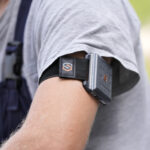The global economy is built on the backs of hardworking “industrial athletes,” and providing those athletes with the equipment to keep them safe is the mission of one New York-based technology firm with ties to insurance.
Executive Summary
Technology-enabled dynamic policies that reward positive behavior and disincentivize at-risk behavior are the future of the workers compensation insurance market. Here, Matt Norcia, COO of StrongArm Technologies, and CM Guest Editor Matteo Carbone discuss the path to that future and the current benefits of StrongArm wearables in detecting individual risk situations, inspiring behavioral changes across worksites and entire facilities, as well as workers comp insurance implications that include lower claim costs and access to digital data for continuous underwriting and risk benchmarking. Photo Credits: StrongArm TechnologiesThe technology firm is StrongArm Technologies, the employer of one of the co-authors of this article (Matt), which has trademarked the term “industrial athletes” to describe those workers who lift and sort countless boxes, deliver mail in any weather, stock grocery store shelves in the middle of the night, and risk physical injury in multiple ways in warehouses and industrial settings to build and maintain the world’s critical infrastructure.
Through IoT wearables, StrongArm Tech has collected millions of hours of safety data, across thousands of industrial workers worldwide, generating a 45 percent reduction in injuries, on average. Workers compensation carrier partners are using the technology to differentiate risk, reduce injuries and empower loss prevention services.
Micro-Level Solutions, Macro-Level Results
A defining characteristic of the Internet of Things is the physical and digital embodiment of the world’s objects—the enhancement of “things” capabilities through the intelligent use of transferred information. IoT solutions have a pervasive presence in the life of any person and any organization, and can be observed at different levels:








































